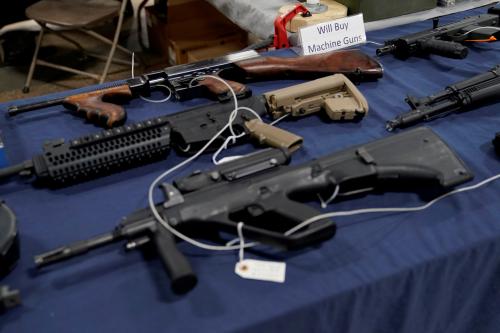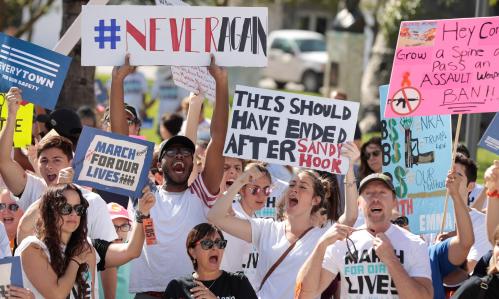The recent school shooting in Uvalde, Texas, that left 19 children and two adults deceased reopened wounds of the Sandy Hook, Buffalo, and Parkland shootings for many Americans. Each of those 19 children excitedly left his or her home Tuesday morning to enjoy one of the last days of school, completely unaware the hours and minutes that followed would be their very last on Earth. Politics aside, we owe it to their memories to re-examine our “thoughts and prayers” approach to gun reform.
As an emergency radiologist, at one of the nation’s busiest level 1 trauma centers, I routinely utilize “x-ray vision” to save lives. In my chosen practice of medicine, black and white imagery is generated using x-rays to assist the diagnosis of life-threatening trauma or illness. This was the case in April of 2018, when I was directly involved in providing care for multiple victims of the Nashville Waffle House mass shooting. This tragic event, like Uvalde, occurred at the hands of a gunman armed with an AR-15 (Armalite 15) military-style assault rifle and ultimately resulted in the loss of four innocent lives.
Let me first state, patients presenting to emergency rooms with firearm injuries are unfortunately a common place in America. As such, emergency radiologists, like me, are trained to develop proficient skills in recognizing and postulating penetrating ballistic injury pathways. A typical handgun leaves a very characteristic gray linear tract through soft tissues or organs, which correlates to the size and trajectory of the bullet. Small bullet fragments and bleeding may be seen in association with the gunshot injury, but general anatomy is often left recognizable.
In contrast, the injury patterns seen in relation to AR-15 military-style assault rifles are somewhat indescribable. Bullets fired from these weapons exit the barrel at supersonic speeds that are 3x faster than conventional low velocity handguns. The increased velocity rate of these projectiles results in a cavitation effect on impact with the human body, such that the bullet causes a ripple wave of destruction to arteries, veins and soft tissues. Organs that experience high velocity gun injury are left eviscerated. Bony structures that are directly impacted by these ballistic missiles are reduced to rubble. The exit wounds associated with AR-15 firearms are often the size of grapefruits. Simply put, when Surgeons attempt life-saving measures in these cases, there is often nothing salvageable to fix.
These weapons are often employed on the battlefield to exact the maximum amount of damage possible with the strike of each bullet. Witnessing their devastating impact on unsuspecting school children, grocery shoppers, and churchgoers is unfathomable. The level of destruction, disfigurement, and disregard for life that a high-powered assault rifle inflicts on the human body cannot be understated. Placed into perspective, many of the tiny Uvalde victims’ bodies were so tattered and dismembered from their ballistic injuries, DNA matching was required for identification because physical/visual identification was not possible.
As a proud registered gun owner, I wholly support our Second Amendment’s right to bear arms. I simply would like to suggest that supporting the right to bear arms in a responsible manner should not be a mutually exclusive ideation. Common sense gun reform that includes background checks and increases the age minimum to legally own military-style assault rifles should be immediately considered. In fact, we need to engage in a real, morally and civically driven debate about whether there is a need for military styled firearms in a civilized society at all.
While mental illness certainly plays a factor in these repeated horrific events, we must examine the policies that have allowed these weapons of destruction into the hands of the mentally ill. Not doing so and expecting a different result is akin to driving in circles at a dead-end cul-de-sac. If age limits were in place to prevent purchasing AR-15 style weapons to those under 21, the Buffalo and Uvalde shootings may have been avoided, given both perpetrators were only 18 years old. If proper background checks were in place, the Buffalo shooter, who had recently undergone mental evaluation after a school shooting threat, may have been prevented from purchasing weapons to commit such a heinous act.
As we move forward, there is certainly added value for policymakers to hear directly from physicians, such as myself, who have witnessed the atrocities of military assault weapons on civilian bodies. Visualizing, first-hand, these black and white images of mass shooting victims may serve to bring a heightened perspective to their policy decisions. At the very least, these interactions would remove the anonymity of the gunshot victim’s injuries and allow lawmakers to face the reality of their policy decisions – or non-decisions.
Let me close by stating, this is not a politically derived opinion piece. As a physician, I do not interpret CT’s or MRIs from a red lens or a blue lens. Partisanship does not factor into my assessments or impressions of a ballistic injury’s severity. The last name of the President holds no precedent over my medical observations. I just simply can no longer remain silent in a world that allows purchasing an AR-15 to be an easier task than finding baby formula.





Commentary
Examining gun reform with x-ray vision
May 27, 2022